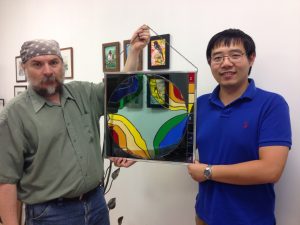
Urii Guchenia, left, and Ran Hong proudly hold up a stained-glass rendering of the magnetic field in the Muon g-2 experiment’s storage ring. Photo courtesy of Ran Hong
Particle physics and decorative glassware are two disciplines that don’t often meet. But given the striking results of a recent artist-scientist collaboration, perhaps that could change.
Artists Nataliya Guchenia and Urii Guchenia at the Chicagoland Nathalie Studio created stained-glass artwork as a representation of the magnetic field inside the Muon g-2 experiment at Fermilab. The centerpiece of Muon g-2 is a 15-meter-diameter ring-shaped magnet through which particles called muons shoot round at high speed.
To do the experiment, scientists have to keep the magnetic field throughout the whole ring extremely uniform and check it regularly so they can make tweaks. Earlier this year, the scientists took one of many measurements of just how uniform the field was. Slices from around the whole ring were squashed into a 2-D map, and it’s this very map that is now immortalized in glass.
The different colors of glass represent the amount of imperfection in the field, with the red and blue areas showing the greatest nonuniformities. Although it looks as though there are huge variations in the field between the center and the edges, even the darkest colors in the map represent a discrepancy from the desired field strength of just two parts per million. And it’s getting even better.
“The map in glass is actually already outdated,” said Muon g-2 scientist Ran Hong, scientist at Argonne National Laboratory who came up with the idea and owns the artwork. “We’ve since corrected for the nonuniformities at that level and are now getting it even more uniform.”
The artwork saw attention from the public at Fermilab’s 50th anniversary Open House when it was displayed in Muon g-2’s building. It now hangs in Hong’s office.
“If I cannot draw a physics concept in pictures, I don’t think I understand it,” said Hong. “When I or the public see a visualization, it gets rid of the math, and we can think more about the physics behind it and why it is the way it is.”




